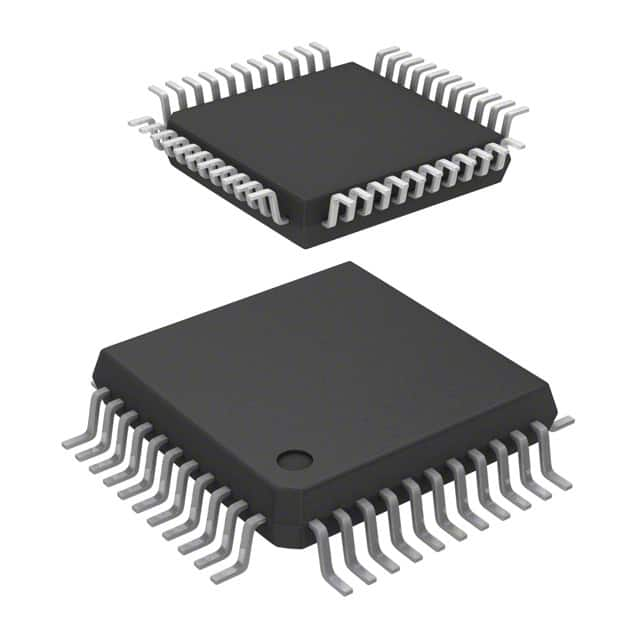ST72C334J4T6
Product Overview
- Category: Microcontroller
- Use: Embedded systems, control applications
- Characteristics:
- Low power consumption
- High performance
- Wide operating voltage range
- Integrated peripherals
- Package: TQFP (Thin Quad Flat Package)
- Essence: A microcontroller designed for embedded systems and control applications.
- Packaging/Quantity: Available in tape and reel packaging, quantity varies based on customer requirements.
Specifications
- Architecture: 8-bit
- CPU Frequency: Up to 16 MHz
- Flash Memory: 32 KB
- RAM: 1.5 KB
- Operating Voltage Range: 2.7V to 5.5V
- I/O Pins: 34
- Timers: 3
- Communication Interfaces: SPI, UART
- Analog-to-Digital Converter (ADC): 8 channels, 10-bit resolution
- Operating Temperature Range: -40°C to +85°C
Detailed Pin Configuration
The ST72C334J4T6 microcontroller has a total of 34 pins. The pin configuration is as follows:
- Pins 1 to 7: Port A (PA0 to PA6)
- Pins 8 to 15: Port B (PB0 to PB7)
- Pins 16 to 23: Port C (PC0 to PC7)
- Pins 24 to 31: Port D (PD0 to PD7)
- Pin 32: VDD (Power supply)
- Pin 33: VSS (Ground)
- Pin 34: OSCIN/OSCOUT (Oscillator input/output)
Functional Features
- High-performance 8-bit CPU with an efficient instruction set
- Integrated peripherals such as timers, communication interfaces, and ADC
- Low power consumption for energy-efficient applications
- Wide operating voltage range allows for flexibility in power supply options
- Flash memory for program storage and EEPROM for data storage
- Built-in oscillator circuitry for clock generation
Advantages and Disadvantages
Advantages: - High performance and low power consumption make it suitable for a wide range of applications. - Integrated peripherals reduce the need for external components, saving cost and board space. - Wide operating voltage range allows for compatibility with different power supply options.
Disadvantages: - Limited RAM capacity may restrict the complexity of applications. - 8-bit architecture may not be suitable for certain high-performance applications.
Working Principles
The ST72C334J4T6 microcontroller operates based on an 8-bit architecture. It executes instructions stored in its flash memory to perform various tasks. The integrated peripherals, such as timers and communication interfaces, enhance its functionality. The microcontroller communicates with external devices through its I/O pins and interfaces, enabling control and data exchange.
Detailed Application Field Plans
The ST72C334J4T6 microcontroller is widely used in various embedded systems and control applications, including but not limited to:
- Industrial automation: Control of machinery, process monitoring, and data acquisition.
- Home automation: Smart home devices, lighting control, and security systems.
- Automotive electronics: Engine control units, dashboard displays, and vehicle diagnostics.
- Consumer electronics: Remote controls, gaming consoles, and home appliances.
- Medical devices: Patient monitoring systems, medical equipment control, and diagnostics.
Detailed and Complete Alternative Models
- ST72F264G2M6: Similar microcontroller with higher flash memory capacity (64 KB).
- ST72F521AR9T6: Microcontroller with additional features like CAN bus interface and more I/O pins.
- ST72F325J7T6: Microcontroller with larger RAM capacity (2 KB) and additional communication interfaces.
These alternative models offer different specifications and features, allowing users to choose the most suitable microcontroller for their specific application requirements.
Word count: 511 words
Lista 10 Vanliga frågor och svar relaterade till tillämpningen av ST72C334J4T6 i tekniska lösningar
Sure! Here are 10 common questions and answers related to the application of ST72C334J4T6 in technical solutions:
Q: What is the ST72C334J4T6 microcontroller used for? A: The ST72C334J4T6 microcontroller is commonly used in various technical solutions, such as industrial control systems, automotive applications, and consumer electronics.
Q: What is the maximum clock frequency supported by the ST72C334J4T6? A: The ST72C334J4T6 microcontroller supports a maximum clock frequency of 8 MHz.
Q: How much flash memory does the ST72C334J4T6 have? A: The ST72C334J4T6 microcontroller has 32 KB of flash memory.
Q: Can I use the ST72C334J4T6 for real-time applications? A: Yes, the ST72C334J4T6 microcontroller can be used for real-time applications due to its fast execution speed and interrupt handling capabilities.
Q: Does the ST72C334J4T6 support analog-to-digital conversion (ADC)? A: No, the ST72C334J4T6 microcontroller does not have an integrated ADC. However, external ADCs can be interfaced with it if required.
Q: What communication interfaces are available on the ST72C334J4T6? A: The ST72C334J4T6 microcontroller supports serial communication interfaces like UART (Universal Asynchronous Receiver-Transmitter) and SPI (Serial Peripheral Interface).
Q: Can I program the ST72C334J4T6 using C language? A: Yes, the ST72C334J4T6 microcontroller can be programmed using C language. It also supports assembly language programming.
Q: What is the operating voltage range of the ST72C334J4T6? A: The ST72C334J4T6 microcontroller operates within a voltage range of 2.7V to 5.5V.
Q: Does the ST72C334J4T6 have any built-in hardware timers? A: Yes, the ST72C334J4T6 microcontroller has multiple built-in hardware timers that can be used for various timing and synchronization tasks.
Q: Is the ST72C334J4T6 suitable for low-power applications? A: Yes, the ST72C334J4T6 microcontroller has power-saving features like sleep mode and low-power consumption, making it suitable for low-power applications.
Please note that these answers are based on general information about the ST72C334J4T6 microcontroller and may vary depending on specific implementation requirements.


